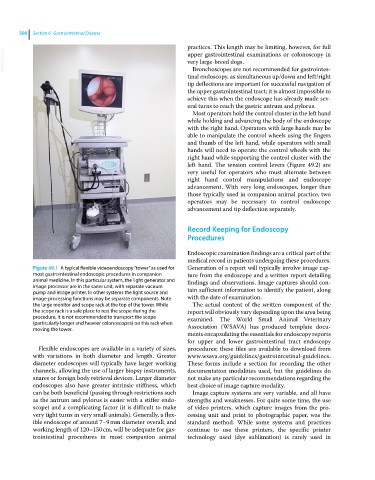Page 540 - Clinical Small Animal Internal Medicine
P. 540
508 Section 6 Gastrointestinal Disease
practices. This length may be limiting, however, for full
VetBooks.ir upper gastrointestinal examinations or colonoscopy in
very large‐breed dogs.
Bronchoscopes are not recommended for gastrointes-
tinal endoscopy, as simultaneous up/down and left/right
tip deflections are important for successful navigation of
the upper gastrointestinal tract; it is almost impossible to
achieve this when the endoscope has already made sev-
eral turns to reach the gastric antrum and pylorus.
Most operators hold the control cluster in the left hand
while holding and advancing the body of the endoscope
with the right hand. Operators with large hands may be
able to manipulate the control wheels using the fingers
and thumb of the left hand, while operators with small
hands will need to operate the control wheels with the
right hand while supporting the control cluster with the
left hand. The tension control levers (Figure 49.2) are
very useful for operators who must alternate between
right hand control manipulations and endoscope
advancement. With very long endoscopes, longer than
those typically used in companion animal practice, two
operators may be necessary to control endoscope
advancement and tip deflection separately.
Record Keeping for Endoscopy
Procedures
Endoscopic examination findings are a critical part of the
medical record in patients undergoing these procedures.
Figure 49.1 A typical flexible videoendoscopy “tower” as used for Generation of a report will typically involve image cap-
most gastrointestinal endoscopic procedures in companion ture from the endoscope and a written report detailing
animal medicine. In this particular system, the light generator and findings and observations. Image captures should con-
image processor are in the same unit, with separate vacuum tain sufficient information to identify the patient, along
pump and image printer. In other systems the light source and
image‐processing functions may be separate components. Note with the date of examination.
the large monitor and scope rack at the top of the tower. While The actual content of the written component of the
the scope rack is a safe place to rest the scope during the report will obviously vary depending upon the area being
procedure, it is not recommended to transport the scope examined. The World Small Animal Veterinary
(particularly longer and heavier colonoscopes) on this rack when Association (WSAVA) has produced template docu-
moving the tower.
ments encapsulating the essentials for endoscopy reports
for upper and lower gastrointestinal tract endoscopy
Flexible endoscopes are available in a variety of sizes, procedures; these files are available to download from
with variations in both diameter and length. Greater www.wsava.org/guidelines/gastrointestinal‐guidelines.
diameter endoscopes will typically have larger working These forms include a section for recording the other
channels, allowing the use of larger biopsy instruments, documentation modalities used, but the guidelines do
snares or foreign body retrieval devices. Larger diameter not make any particular recommendations regarding the
endoscopes also have greater intrinsic stiffness, which best choice of image capture modality.
can be both beneficial (passing through restrictions such Image capture systems are very variable, and all have
as the antrum and pylorus is easier with a stiffer endo- strengths and weaknesses. For quite some time, the use
scope) and a complicating factor (it is difficult to make of video printers, which capture images from the pro-
very tight turns in very small animals). Generally, a flex- cessing unit and print to photographic paper, was the
ible endoscope of around 7–9 mm diameter overall, and standard method. While some systems and practices
working length of 120–150 cm, will be adequate for gas- continue to use these printers, the specific printer
trointestinal procedures in most companion animal technology used (dye sublimation) is rarely used in

